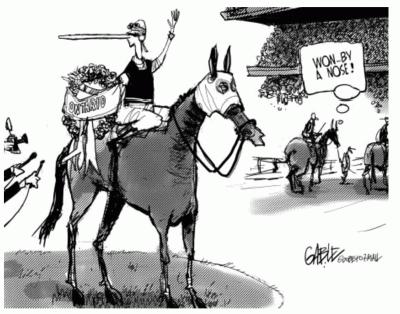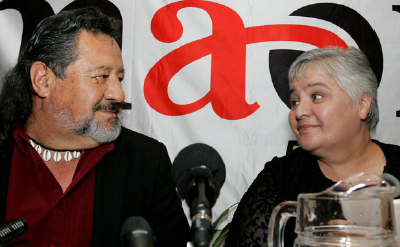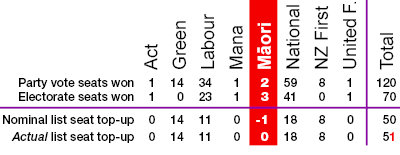Dispatching two electoral review room elephants


Saddled with Unsound System: Ontario remains hobbled to its lame first-past-the-post system, which has finally been put down in Aotearoa by the 15.11-percentage-point referendum win on 26 November. All that remains is to abolish first-past-the-post as the means of choosing electorate representatives, and parties, and coalitions. cartoon Brian Gable | Globe and Mail
Two elephants in the room, are two too many. The Māori roll and size of parliament are the two no-go areas for the Electoral Commission review, which will call for public submissions in mid-February and hold public meetings in April and May.
The two subjects share nothing in common, except that they are off limits in respect to the review and they are features of the electoral system that shouldn’t be changed.
The short politically correct position on the Māori roll is that it should remain, until Māori initiate its abolishment. The long politically correct position is that the Māori roll was introduced in 1867 as a temporary measure, and should be phased out once Māori achieve adequate representation via the general roll. The 1986 Royal Commission on the Electoral System concluded:
The MMP system with a common roll offers what we consider to be optimal conditions for the effective representation of Māori interests. It also offers Māori considerable scope for developing their potential voting strength and for charting their own political future. But in the end it is Māori themselves who must determine how much influence they and their representatives are to have in Parliament and in the wider political system. No matter how good the electoral system is, it will not work to their advantage unless the Māori people commit themselves to participation within it.
The difficulty with perpetuating the view that because it was intended to be temporary the end goal must be its abolition, is that it obfuscates the best reason to retain the Māori roll: It works; or at least now it works. The beautiful irony is that the Māori roll works thanks to the courage of the 1986 royal commission in recommending mixed member proportional, but not for the reasons the commissioners could have guessed at. By recommending a system that was much fairer to fledgling parties, the commission helped create an environment conducive to a Māori party gaining representation, but not thanks to proportional representation. The Māori Party wins all its seats as electorate seats—the party vote and list seats provide no assistance whatsoever.

Roll Model: The ‘last cab off the rank’ Māori Party has demonstrated that far from needing to be abolished, the Māori roll is an exemplar worthy of extension, both in Aotearoa and elsewhere, to help facilitate fair representation of ethnic and indigenous minorities. image Sunday Star Times
The important question that now needs to be asked is, with the Māori roll finally working well for Māori, why should other rolls not be contemplated. At the 2006 census, 6.9% of New Zealanders are classed as Pasifika. This means that a Pasifika roll with up to eight Pasifika electorates could be created, if the concept was wholeheartedly embraced. With Carmel Sepuloni losing National’s mean-minded move—through a judicial recount—to regain Waitakere, it didn’t increase the party’s seat tally, rather it helped ensure that Pasifika was under-represented in the 50th Parliament by a factor of two. With the Pasifika population continuing to grow rapidly, the courageous response of Parliament would be to invite Pasifika New Zealanders to consider the creation of a new roll.
Turning now to the other elephant. The royal commission recommended a 120-seat parliament, by reducing the then 95 electorates to just 60 and providing for a like number of list seats. Had mixed member proportional been promptly introduced, there would have been one member for every 27 600 residents, which was about the ratio three decades earlier when Parliament had 80 members. An 80-seat parliament was the norm from 1905 until 1969, when it was increased by just four members. If the 1905 ratio had been maintained, Parliament would now house 380 members, which would require, amongst other things, that the plush thrones in which representatives currently become ensconced be replaced by bleachers.
Given the wide variation in ratios of representatives to population in Aotearoa historically, and worldwide, the ‘correct’ size for Parliament in 1999 was 99, the number voted for by 81.5% of New Zealanders who participated in the referendum on the subject. Given that the Labour-led government disdained that decision, and the National-led government in 2009 deigned that the size of Parliament would not to be part of the review of mixed member proportional now underway, the ‘correct’ size for Parliament is 120. By cute coincidence, this is the ratio of representation when Parliament last had 99 members.
When the Botany Electorate was created, the number of list seats was reduced from 60 to 59. This process cannot continue without proportionality eventually suffering, unless there is a change to mixed member proportional that would reduce the need for having roughly half the seats list seats. Fortunately, not only does such a solution exist, its implementation would purge mixed member proportional of its first-past-the-post vestiges.

Barely Unbalanced: The anomaly whereby an extra seat results from the Māori Party’s ability to win electorate seats, but not party vote share, is an aberration hardly worth fixing, much less fixating upon, and not even in Bolivia or Lesotho, where no ‘overhang’ is tolerated, are electorate seats taken off a party. chart Mahurangi Magazine
Mixed member proportional uses a two-vote system to address the disproportionality that results from first-past-the-post electorate contests. As a consequence, the stronger of the two major parties enjoys a landslide of electorate seats—National winning nearly twice as many as Labour in 2011—while the third party wins none. The solution is to allow voters to express a second or more preference. This limits the respective landslide and drought effects for the second and third strongest parties, meaning that fewer list seats are needed to restore proportionality. In 2011, it is likely that the Labour Party would have lost five or six fewer electorates—six, had Rongotai electors given Green co-leader Russel Norman sufficient second preferences. Even Wellington Central could have gone to the Greens, in a Wellington mayoralty -style, from behind win.
Aside from Rongotai, Wellington Central, and one or two other Green strongholds, and under the current mixed member proportional implementation, rational Green Party supporters, having given their party vote to Green, would overwhelmingly vote for Labour electorate candidates. The fact that they don’t—in 2011, 70% also voted for Green electorate candidates—is further proof that this vestige of first-past-the-post should be expunged from mixed member proportional. The beauty of preference voting is that the voter does not need to be concerned with who might be the front-runners and chose the lesser of two evils. All that is required is for the voter to rank as many or as few candidates according to her genuine preference. In fact there is no technical reason why voters shouldn’t be permitted to rank two or more candidates equally—something not a few of the 7864 Rodney Electorate candidates who voted either for Green Party candidate Teresa Moore or ‘Green candidate in the red corner’ Christine Rose, might have wished they could do.
Since its introduction with 60 list seats and 60 electorate seats, the mixed member proportional ratio of list to electorate seats has been reduced to 51 to 69. This is due to the imperative to add electorate seats to absorb population growth. Unsurprisingly, the newest seat is south of Auckland: The Howick Electorate. A consequence of reducing the number of list seats is that a so-called overhang is made more likely. An overhang occurs when a party gains more seats than its party vote entitles it to, and under the German and Aotearoa implementation of mixed member proportional, this increases the size of Parliament—by two seats in 2008 and one in 2011—as a result of Māori Party strength in winning electorate seats.
While a certain amount of angst over overhang seats is undoubtedly racially motivated, the legitimate concern is that it reduces the proportional purity that is mixed member’s unmatched virtue. For example, in 2008 Act received 3.65% of the party vote and five seats, but the Māori Party won the same number of seats with only 2.39% of the party vote. However, this is looking at the issue through the wrong end of the electoral microscope. The Māori Party won its five electorate seats outright (which incidentally would also have been the case if preference voting had been allowed). In no way should the smallness of its party vote be seen as evidence that Māori Party was not entitled to be represented by those five successful candidates.
To summarise, the Electoral Commission review will not consider either the size of Parliament or the abolishment of the Māori seats. This is an arbitrary and unneeded curtailment of a much-needed discussion of the electoral landscape. Since its introduction 144 years ago, Māori have strenuously resisted moves to abolish the Māori roll. Now that it is finally working well for Māori, rather than be abolished, the roll should be embraced and seen as a template for Pasifika and any other communities that struggle to gain fair representation—judging by its paltry 11% party vote, the Green Party should campaign strenuously for a Green Growth roll for the 85.9% of New Zealanders surveyed recently who responded ‘very important’ or ‘important’ to the question:
How important do you think sustainability is in providing New Zealand with a competitive advantage in global markets (for example, in spirit of 100% Pure brand campaign)
And while it is a disgrace and a travesty that Parliament thumbed its nose at the 1999 referendum, population growth has eroded part of the case for a return to 99 members. Even without the issue of the size of Parliament and the Māori roll, there is much to play for in the Electoral Commission review, hence this small contribution towards dealing with what could prove to be two all-too distracting elephants in the commission review room.
With boldness and imagination, Aotearoa could evolve the smartest and most user-friendly implementation of mixed member proportional yet.

Another vestige of the first-past-the-post system is the way votes are counted, or, rather, recounted.
According to New Zealand Herald reporters there were more than 400 votes discounted as informal in Waitakere, because they only had a mark, not the ‘tick’ demanded by law. Tick, as in a short diagonally downward stroke to the right, and a longer upward stroke, linked in the same direction, as per custom. Not the dots, crosses or diagonal slashes that some people use when ‘ticking’ a box. Given that the vote has been determined by a bare two handfuls, this method of counting or discounting democracy is long overdue for review, as well, me thinkages. Agreed on the Green Roll.
Tracey Barnett had an excellent op-ed in the New Zealand Herald entitled, ‘The man, but not the mandate’ one of the most commented upon columns on the paper’s site, regarding asset sales, mining, et al. Not that you would know because the New Zealand Herald appears to be gaming its ‘most commented’ section on its front page, not on a first-past-the-post basis, i.e. the most numerically popular columns or stories, but by an undeclared mixed-member-proportional-style selection of sharing links among the ‘most commented.’ Thus they were able to drop the Tracey column off the front page and introduce less popular, more tory-friendly fare.
Oh, and the New Zealand Herald asked Tracey not to write it any more columns.